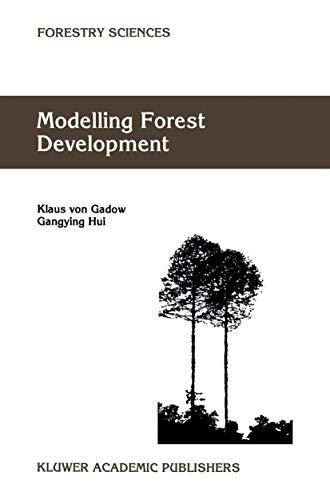
Inhaltsangabe
In an lUlffianaged woodland, forest development follows a succession of periods of undisturbed natural growth, interrupted by intermediate loss or damage of trees caused by fire or wind or other natural hazards. In a managed woodland, the most important periodic disturbances are the thinning operations, which are often carried out at regular intervals and which usually have a significant effect on the future evolution of the resource. Thus, a realistic model of forest development includes both natural growth and thinnings. The key to successful timber management is a proper understanding of growth processes, and one of the objectives of modelling forest development is to provide the tools that enable foresters to compare alternative silvicultural treatments. Foresters need to be able to anticipate the consequences of a particular thinning operation. In most cases, total timber volume is not a very appropriate measure for quantifying growth or yields, or changes caused by thinning operations. Yield in economic terms is defined by the dimensions and quality attributes of the harvestable logs, and estimating timber products is a central issue of production-oriented growth and yield research. Introduction 2 Growth modelling is also an essential prerequisite for evaluating the consequences of a particular management action on the future development of an important natural resource, such as a woodland ecosystem.
Die Inhaltsangabe kann sich auf eine andere Ausgabe dieses Titels beziehen.
Über die Autorin bzw. den Autor
Charlotte y Peter Fiell son dos autoridades en historia, teoría y crítica del diseño y han escrito más de sesenta libros sobre la materia, muchos de los cuales se han convertido en éxitos de ventas. También han impartido conferencias y cursos como profesores invitados, han comisariado exposiciones y asesorado a fabricantes, museos, salas de subastas y grandes coleccionistas privados de todo el mundo. Los Fiell han escrito numerosos libros para TASCHEN, entre los que se incluyen 1000 Chairs, Diseño del siglo XX, El diseño industrial de la A a la Z, Scandinavian Design y Diseño del siglo XXI.
„Über diesen Titel“ kann sich auf eine andere Ausgabe dieses Titels beziehen.
Weitere beliebte Ausgaben desselben Titels
Suchergebnisse für Modelling Forest Development: 57 (Forestry Sciences,...
Modelling Forest Development (Forestry Sciences, 57)
Anbieter: Ria Christie Collections, Uxbridge, Vereinigtes Königreich
Zustand: New. In. Artikel-Nr. ria9781402002762_new
Neu kaufen
Anzahl: Mehr als 20 verfügbar
Modelling Forest Development
Anbieter: Majestic Books, Hounslow, Vereinigtes Königreich
Zustand: New. pp. 228 49:B&W 6.14 x 9.21 in or 234 x 156 mm (Royal 8vo) Perfect Bound on White w/Gloss Lam. Artikel-Nr. 7388719
Neu kaufen
Anzahl: 1 verfügbar
Modelling Forest Development
Anbieter: Kennys Bookstore, Olney, MD, USA
Zustand: New. The key to successful timber management is a proper understanding of growth processes. This work provides the tools that enable foresters to compare alternative silvicultural treatments. It also provides worked examples and code where appropriate. It is intended for graduate students. Series: Forestry Sciences. Num Pages: 222 pages, biography. BIC Classification: TVR. Category: (G) General (US: Trade); (P) Professional & Vocational. Dimension: 235 x 155 x 12. Weight in Grams: 720. . 2001. Softcover reprint of the original 1st ed. 1999. Paperback. . . . . Books ship from the US and Ireland. Artikel-Nr. V9781402002762
Modelling Forest Development
Anbieter: preigu, Osnabrück, Deutschland
Taschenbuch. Zustand: Neu. Modelling Forest Development | Klaus von Gadow (u. a.) | Taschenbuch | ix | Englisch | 2001 | Springer | EAN 9781402002762 | Verantwortliche Person für die EU: Springer Verlag GmbH, Tiergartenstr. 17, 69121 Heidelberg, juergen[dot]hartmann[at]springer[dot]com | Anbieter: preigu. Artikel-Nr. 102697626
Neu kaufen
Anzahl: 5 verfügbar
Modelling Forest Development
Anbieter: AHA-BUCH GmbH, Einbeck, Deutschland
Taschenbuch. Zustand: Neu. Druck auf Anfrage Neuware - Printed after ordering - In an lUlffianaged woodland, forest development follows a succession of periods of undisturbed natural growth, interrupted by intermediate loss or damage of trees caused by fire or wind or other natural hazards. In a managed woodland, the most important periodic disturbances are the thinning operations, which are often carried out at regular intervals and which usually have a significant effect on the future evolution of the resource. Thus, a realistic model of forest development includes both natural growth and thinnings. The key to successful timber management is a proper understanding of growth processes, and one of the objectives of modelling forest development is to provide the tools that enable foresters to compare alternative silvicultural treatments. Foresters need to be able to anticipate the consequences of a particular thinning operation. In most cases, total timber volume is not a very appropriate measure for quantifying growth or yields, or changes caused by thinning operations. Yield in economic terms is defined by the dimensions and quality attributes of the harvestable logs, and estimating timber products is a central issue of production-oriented growth and yield research. Introduction 2 Growth modelling is also an essential prerequisite for evaluating the consequences of a particular management action on the future development of an important natural resource, such as a woodland ecosystem. Artikel-Nr. 9781402002762
Neu kaufen
Anzahl: 1 verfügbar

